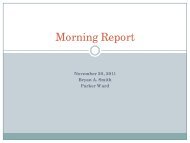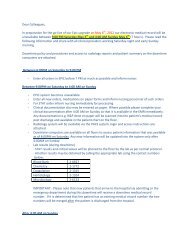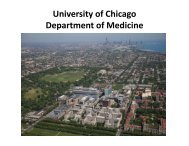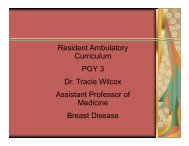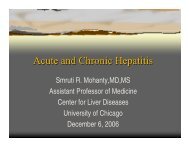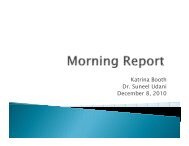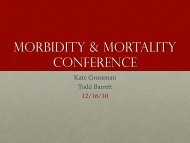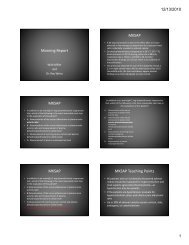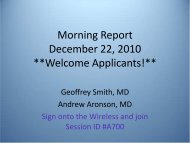Sickle Cell Disease and Acute Chest
Sickle Cell Disease and Acute Chest
Sickle Cell Disease and Acute Chest
You also want an ePaper? Increase the reach of your titles
YUMPU automatically turns print PDFs into web optimized ePapers that Google loves.
Morning Report<br />
4/18/12<br />
Dr. Dudley<br />
Jen McDonnell
MKSAP<br />
A 19-year 19 year-old old black man is evaluated in the emergency<br />
department for a 2-day 2 day history of pain in the upper <strong>and</strong><br />
lower extremities <strong>and</strong> back. His medical history<br />
includes episodes of achy pain in his extremities <strong>and</strong><br />
back, but this is the first time his pain was severe<br />
enough to seek medical attention. Medical history is<br />
also remarkable for anemia of unknown cause. Family<br />
history is positive for anemia. Other than poor exercise<br />
tolerance, the patient has no other medical problems,<br />
no allergies, <strong>and</strong> takes no medications.
MKSAP<br />
On physical examination, there are mildly icteric<br />
sclerae. sclerae.<br />
Temperature is 37.2 °C C (99.0 °F), F), blood<br />
pressure is 126/62 mm Hg, pulse rate is<br />
112/min, <strong>and</strong> respiration rate is 18/min; BMI is<br />
22. There is no splenomegaly<br />
or hepatomegaly<br />
on abdominal examination.
Laboratory studies:<br />
Hemoglobin<br />
Leukocyte count<br />
MKSAP<br />
10.2 g/dL<br />
(102 g/L)<br />
109/L)<br />
8600/µL 8600/ L (8.6 ×<br />
Mean corpuscular volume<br />
70 fL<br />
Total bilirubin<br />
5.7 mg/dL mg/ dL (97.5 µmol/L) mol/L)<br />
Direct bilirubin<br />
0.3 mg/dL mg/ dL (5.1 µmol/L) mol/L)<br />
The peripheral blood smear shows rare sickled<br />
erythrocytes <strong>and</strong> target cells.
MKSAP<br />
Hemoglobin electrophoresis:<br />
Hemoglobin S<br />
Hemoglobin F<br />
Hemoglobin A<br />
Hemoglobin A2 A<br />
67% (0%)<br />
3% (0%-2%) (0% 2%)<br />
25% (94.8%-97.8%)<br />
(94.8% 97.8%)<br />
5% (2.2%-3.2%) (2.2% 3.2%)
1.<br />
2.<br />
3.<br />
4.<br />
MKSAP<br />
Which of the following is the most likely<br />
diagnosis?<br />
<strong>Sickle</strong> cell trait<br />
Sβ+ + thalassemia<br />
Hemoglobin SC disease<br />
Hemoglobin S with hereditary persistence of<br />
fetal hemoglobin
1.<br />
2.<br />
3.<br />
4.<br />
Which of the following is the most likely diagnosis?<br />
<strong>Sickle</strong> <strong>Cell</strong> Trait<br />
S+ Thal<br />
SC <strong>Disease</strong><br />
Hemoglobin S with<br />
hereditary persistence of HF<br />
25% 25% 25% 25%<br />
1 2 3 4
MKSAP<br />
This patient has Sβ+ + thalassemia, thalassemia,<br />
characterized by a hemoglobin<br />
S level that is greater than 60%, with an elevated hemoglobin A2<br />
level <strong>and</strong> mild microcytosis. microcytosis.<br />
These patients have painful crises,<br />
but to a lesser extent than patients homozygous for hemoglobin<br />
S. Patients with Sβ+ + thalassemia<br />
have target cells <strong>and</strong> few or no<br />
sickled<br />
erythrocytes on the peripheral blood smear. Patients with<br />
sickle cell trait (AS), who are often confused with patients with with<br />
Sβ+ + thalassemia, thalassemia,<br />
have a hemoglobin S level that is less than 50%<br />
<strong>and</strong> a hemoglobin A level that is correspondingly greater than<br />
50%. Patients with the sickle cell trait also have normal-sized<br />
normal sized<br />
erythrocytes. Patients with hemoglobin SC disease have painful<br />
crises in addition to an approximately 50:50 ratio of hemoglobin<br />
S to hemoglobin C on electrophoresis.
MKSAP<br />
On physical examination, there are mildly icteric<br />
sclerae. sclerae.<br />
Temperature is 37.2 °C C (99.0 °F), F), blood<br />
pressure is 126/62 mm Hg, pulse rate is<br />
112/min, <strong>and</strong> respiration rate is 18/min; BMI is<br />
22. There is no splenomegaly<br />
or hepatomegaly<br />
on abdominal examination.
Chief Complaint<br />
23 year old male with sickle cell disease coming<br />
to the ER with upper <strong>and</strong> lower extremity pain.
HPI<br />
Pain in upper <strong>and</strong> lower extremities for the past<br />
week. Pain sensation <strong>and</strong> distribution is typical<br />
of VOC for patient. Started home pain regimen<br />
3 days prior to admission but unable to control<br />
pain. No fevers, no chills, no chest pain, no<br />
SOB, abdominal pain, constipation, diarrhea.<br />
Patient has had a chronic tibial<br />
ulcer-thinks may<br />
be draining slightly more, but no other changes<br />
to ulcer.
Key Items in <strong>Sickle</strong> <strong>Cell</strong> History<br />
Current symptoms<br />
<br />
Paying close attention to<br />
signs of infection, ACS,<br />
abdominal pathology<br />
Past history:<br />
<br />
<br />
<br />
<br />
Previous ACS, other<br />
complications<br />
Recent<br />
hospitalizations/complications<br />
Frequency of complications<br />
History of stroke<br />
<br />
<br />
Complications from<br />
SCD<br />
<br />
<br />
<br />
<br />
Pulmonary HTN<br />
Hemochromatosis<br />
Renal dysfunction<br />
AVN<br />
Medical Regimen<br />
<br />
<br />
Home meds<br />
Previous hospitalization<br />
pain meds/PCA
PMH:<br />
Hg SS disease<br />
Pulmonary HTN-mild<br />
History of CVA-age 17, no<br />
residual deficits<br />
RLE DVT 1 year ago<br />
AVN L hip<br />
ACS X 3<br />
<strong>Acute</strong> cholecystitis<br />
Migraines<br />
Allergies: NKDA<br />
PMH<br />
<br />
<br />
<br />
Medications:<br />
Morphine IR 15mg PO Q3-4h<br />
PRN<br />
Morphine SR 30mg BID<br />
Hydroxyurea 1500mg daily<br />
Folic acid 1mg daily<br />
Social History: Lives with<br />
girlfriend, 3 y/o daughter,<br />
gr<strong>and</strong>parents. Tob: 3 cigs/day<br />
ETOH: rare +marijuana-last use 3<br />
weeks ago<br />
Family History: Sister with sickle<br />
cell disease, died at the age of 18<br />
months.
Physical Exam<br />
T 36.2 HR 76 BP 124/60 RR 18 SPO2: 100% 2L NC (98% RA)<br />
Constitutional: He is oriented <strong>and</strong> conversant, appears uncomfortable<br />
HENT: Eyes: Conjunctivae normal, EOMI. Pupils are equal, round, <strong>and</strong><br />
reactive to light. Neck supple.<br />
Cardiovascular: Regular rate <strong>and</strong> regular rhythm, S1, S2 present, S2 slightly<br />
pronounced, no murmurs, rubs, or gallops. No lift of heave<br />
Pulmonary: Effort normal <strong>and</strong> breath sounds normal. No respiratory distress.<br />
No wheezes. No rales.<br />
Abdominal: Bowel sounds are normal. No distension. Soft. No tenderness.<br />
No rebound <strong>and</strong> no guarding.<br />
Musculoskeletal: Diffusely painful to light touch on all 4 extremities<br />
Neurological: He is alert <strong>and</strong> oriented. No cranial nerve deficit. Coordination<br />
normal.<br />
Skin: open right tibial ulcer 7cm X 8cm X 4cm
10.8<br />
144<br />
3.7<br />
11.4<br />
32.4<br />
107<br />
27<br />
515<br />
N 48 L 34 M 11 E5 reactive<br />
lymph 1 myelocyte 1<br />
4<br />
Initial Labs<br />
0.5<br />
Reticulocyte count:7.5% (RPI<br />
2.7)<br />
98<br />
8.4<br />
7.7 3.8<br />
1.4<br />
60 29<br />
84
CXR<br />
FINDINGS:<br />
Mild cardiomegaly, unchanged. Basilar streaking<br />
opacities compatible with scarring or<br />
subsegmental atelectasis, not significantly<br />
changed.<br />
IMPRESSION:<br />
No evidence of infection.
Before starting therapy for VOC, your medical<br />
student asks, what else could cause pain in<br />
sickle cell patient?<br />
<br />
<br />
<br />
<br />
<br />
<br />
<br />
<strong>Acute</strong> chest syndrome<br />
Cholecystitis<br />
Right Upper Quadrant Syndrome<br />
Priapism<br />
Splenic<br />
sequestration<br />
Avascular<br />
necrosis<br />
Vertebral body collapse
What will be your therapy for VOC?
Loading dose<br />
Yes<br />
Relief?<br />
No<br />
PCA<br />
Calculate 24 hour<br />
Dose requirement<br />
Reassess at 30<br />
Minute intervals<br />
Adjust dem<strong>and</strong> interval to q15-30 minutes<br />
2/3 dose<br />
1/3 dose<br />
dem<strong>and</strong><br />
continuous<br />
Set lockout interval to<br />
Q5 minutes during first<br />
2 hours (titrate dose)<br />
Maintain relief with around<br />
the clock dosing
Adjuvant therapies<br />
NSAIDs<br />
ketorolac<br />
IV fluids<br />
Anti-emetics Anti emetics<br />
Anti-histamines<br />
Anti histamines<br />
Anxiolytics<br />
Antidepressants, anticonvulsants, clonidine<br />
neuropathic pain<br />
for
Perception of Addiction
Pseudoaddiction<br />
Concept that patients whose pain is inadequately<br />
treated will develop characteristics frequently<br />
attributed to pain seeking behavoir<br />
<br />
<br />
<br />
<br />
“clock clock watching” watching<br />
Frequent ER visits<br />
Seeking care at multiple sites<br />
Change in demeanor when medical personnel<br />
present
Hospital Course<br />
Patient admitted, placed on IVF, dilaudid PCA<br />
On hospital day #3 05:45, patient noted to be<br />
less responsive with the following vitals: T 36.2<br />
HR 126 BP 87/52 RR 20 SpO2 70% RA <br />
100% 5LNC
CXR<br />
Moderate hypervolemia/CHF. Basilar opacities<br />
nonspecific but could represent<br />
pulmonary infection in the appropriate clinical<br />
context.
21<br />
140<br />
6.4<br />
98<br />
20<br />
Lactic acid 10.1<br />
9.4<br />
27.5<br />
434<br />
32<br />
2.9<br />
80<br />
Labs<br />
7.9<br />
2.6<br />
8.8<br />
6.9 3.5<br />
8.6<br />
ABG: 7.28/49/139/94% on 5L NC<br />
366 321<br />
87<br />
1.9/6.7
Hospital Course<br />
Patient initially given 1L fluid bolus with follow<br />
up BP 90/60. Patient continued to require<br />
increased oxygen support.<br />
RRT called: patient treated for hyperkalemia,<br />
transferred to MICU
ACS<br />
Definition: new pulmonary infiltrate +/-<br />
fever, chest pain,<br />
tachypnea, tachypnea,<br />
cough, dyspnea, dyspnea,<br />
wheezing<br />
Major cause of ICU admissions <strong>and</strong> death in sickle cell<br />
population<br />
Incidence 10.5 per 100 patient years<br />
Frequently develops after admission for VOC<br />
Mortality: 9% in adults<br />
Infections: Strep pneumo, pneumo,<br />
E coli, Haemophilus,<br />
Haemophilus,<br />
legionella, legionella,<br />
CMV,<br />
S aureas, aureas,<br />
chlamydia
ACS
ACS Treatment<br />
Simple or exchange transfusion-<br />
small studies have<br />
not shown a difference in two, however, most<br />
recommend use of exchange transfusion for severe<br />
cases, those not responsive to simple transfusion<br />
Antibiotics:<br />
3 rd rd-4 th generation cephalosporin +<br />
macrolide, macrolide,<br />
or based on local resistance/risk factors. No<br />
RCT has been done for abx, abx,<br />
but usually given<br />
Inhaled NO:<br />
Current studies have shown no<br />
improvement in outcomes
ACS Treatment<br />
Corticosteroids: variable results in studies, not<br />
currently conclusively beneficial<br />
Bronchodilators: used in patients with wheezing,<br />
airway obstruction, but some advocate using for all<br />
patients. No well-powered trial evaluating use.<br />
Anticoagulation: RCT, double blind trial showed<br />
reduction in duration of pain crises, duration of<br />
hospitalization with use of tinzaparin (LMWH)<br />
ECMO: Option for patients who do no respond to<br />
mechanical ventilation
Multi-organ failure syndrome<br />
Multiple definitions, but in general development<br />
of severe dysfunction of at least 2 major organs<br />
(lung, kidney, liver)
What do you need to do exchange<br />
transfusion?
Hemoglobinopathy<br />
Hemoglobin A 8.4%<br />
Hemoglobin A2 4.2%<br />
Hemoglobin F<br />
Hemoglobin S<br />
5.4%<br />
81.3%<br />
evaluation
Exchange Transfusion<br />
Rationale: Exchange sickled RBCs/HgS for<br />
regular RBCs/HgA without increased viscosity,<br />
fluid shifts seen with simple transfusion<br />
Goal: Hg S
Hospital Course<br />
Patient initially transfused 2 units pRBC<br />
by simple<br />
transfusion in MICU, however persistent hypoxia <strong>and</strong><br />
high Hg S level prompted exchange transfusion<br />
Catheter placed <strong>and</strong> exchange transfusion initiated <br />
repeat Hg S 36%<br />
Within 2 days of exchange transfusion, patient’s patient s clinical<br />
status <strong>and</strong> lab values had improved substantially<br />
Patient transferred to floor, full recovery of renal<br />
function, liver function
References<br />
Paul RN et al. 2011. <strong>Acute</strong> chest syndrome: sickle cell disease. Euro J<br />
Haematology 87 (191-207)<br />
Hassell KL et al. 1994. <strong>Acute</strong> Multiorgan Failure Syndrome: A Potentially<br />
Catastrophic Complication of Sever <strong>Sickle</strong> <strong>Cell</strong> Pain Episodes. Am J Med 96:<br />
155-162.<br />
NIH The Management of <strong>Sickle</strong> <strong>Cell</strong> <strong>Disease</strong>. NIH publication: 02-2117.<br />
Shapiro BS et al. 1997. <strong>Sickle</strong> <strong>Cell</strong>-Related Pain: Perceptions of Medical<br />
Practitioners. J of Pain <strong>and</strong> Symptom Management 14 (3): 168-174.<br />
Swerdlow PS. 2006. Red <strong>Cell</strong> Exchange in <strong>Sickle</strong> <strong>Cell</strong> <strong>Disease</strong>. Am Soc<br />
Hematology 48-53.<br />
Gladwin MT <strong>and</strong> E Vichinsky. 2008. Pulmonary Complication s of <strong>Sickle</strong> <strong>Cell</strong><br />
Disase. NEJM 359:2254-65.



